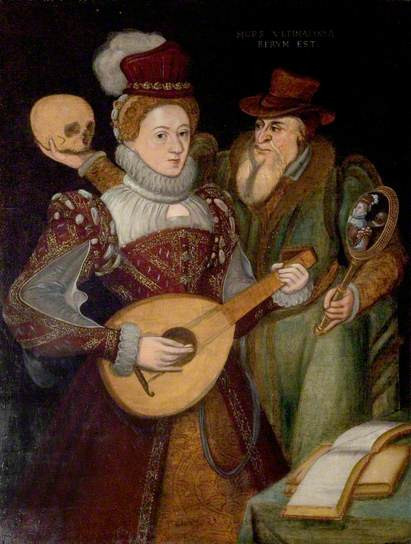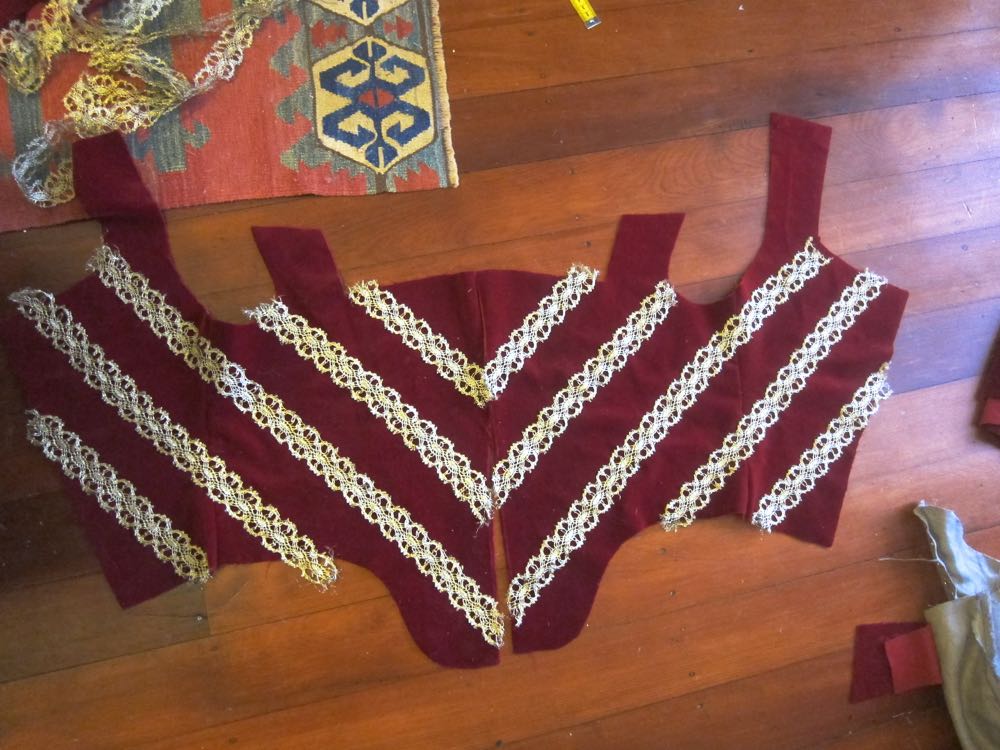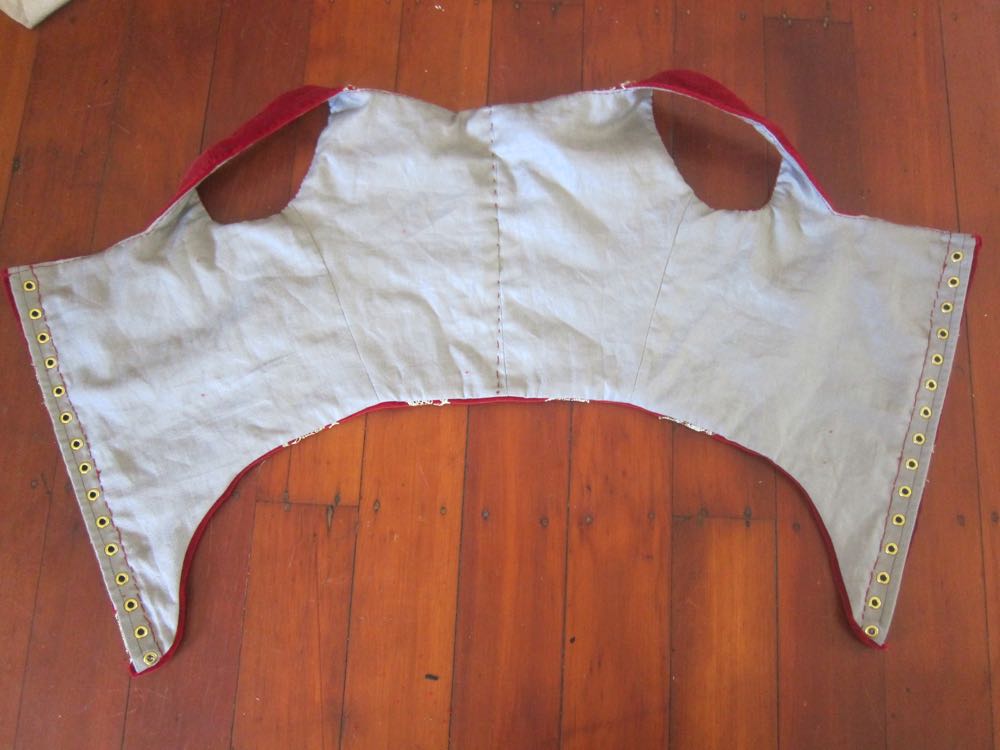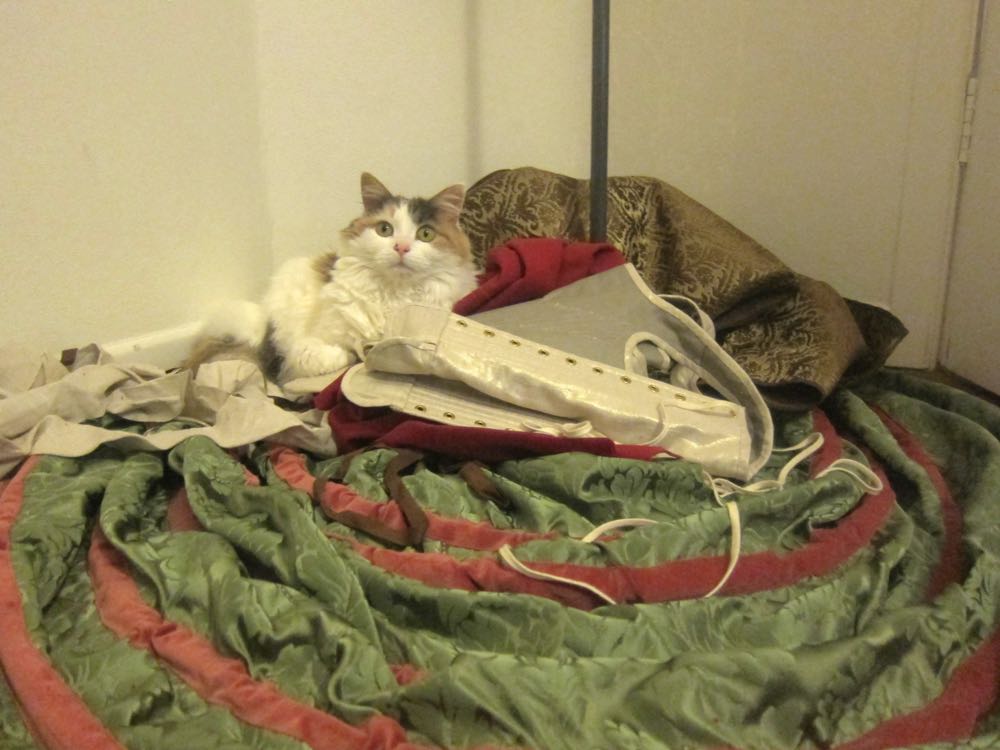The Elizabethan ensemble is moving ahead nicely, though everything is taking longer than I think it will (ergh. New periods. So much research to do. So many mistakes to make, and then unmake, or decide you just can’t fix)
I have made the most important step though. I have an inspiration image!
Isn’t it glorious and fabulous? And doesn’t it look very like all the stuff I’ve already made?
I love the sleeves. I think they are the best Elizabethan sleeves I’ve ever seen. And the diagonal bodice decoration is just delicious.
So, with a real inspiration point, I have decorated the bodice with yet more has-to-be-hand-sewn-on lace:
And installed grommets in my lining.
I’m rather gutted about the grommets. I’d already sewn eyelets to the lining months ago, and when I pulled it out of the UFO pile I assumed I’d made a stupid non-period mistake, and took them out and did the grommets. Then I went back to Arnold, and realised that all of the 16th century gowns Arnold has patterned fasten with hooks at some point or another, so the hooks were accurate, and were based on that.
Still, I never had any hope that this would be 100% period accurate, and she does pattern a girls bodice with lacing under buttons, so it’s not too bad.
And at least my gold trim looks quite amazing:
I did trial the slashing seen in the inspiration painting, but cotton velvet/velveteen does NOT play well with slashing, even with various edge finishes. My lace is so much bolder than that in Death & the Maiden that it’s probably a good thing anyway.
The bodice is completely finished, as is the skirt, and they just need to be joined.
After that there are just the sleeves to go, and the main body of the garment is finished! I’m planning to sew on the sleeve rolls, but have the long open sleeves attach with lacing, so they are detachable (and I’ve totally given up hope that I’ll have them done by Wednesday).
So now I’m working on sleeve rolls, and trim for them, and ruffs.
 I don’t think I’m going to have enough red velvet to make the hat (sniff sniff) so it may have to be black, or red silk.
I don’t think I’m going to have enough red velvet to make the hat (sniff sniff) so it may have to be black, or red silk.

Death and the Maiden, British (English) School, c.1570, Oil on panel, 65 x 49 cm, Shakespeare Birthplace Trust
Plus, there is the mystery of the rest of her headgear. What do you think is going on behind the hat? An elaborately trimmed snood? The under-parts to a French hood?
For now, it’s back to work for Fiss & I:






You drive that cat mercilessly, forcing her to lounge on so many garments. Look at her face -oh, the felinity!
The lace looks wonderful. I wonder how people do/did get on, slashing velvet? I can see the problem. Both velvet and slashing were so popular. Someone must know. What a shame there isn’t enough velvet for the hat. But if you make it in black, you could use the ostrich plume. Happy thought. My guess for the hair underneath the hat is some kind of snood arrangement. Very pretty, too.
Slashing velvet just involves whipstitching the edges after it’s been cut. I have a couple of dresses that I slashed out of velvet. You’ll see it on extant examples – particularly in Men’s garments since there seem to be a few more of them.
But real velvet, especially the period kind, is quite a different beast to modern cotton velvet, which is woven in a different way, and so disintegrates much more easily 🙂
I know, I work poor Fiss so hard! 😉
Period velvet is quite different to the modern cotton velvet (which is really more a velveteen) of the curtains, so a ‘real’ velvet would withstand slashing, possibly, as Isabella suggests, with a bit of topstitching.
I may just have enough red velvet for the hat, but the sleeves are more important to me, so I’ll get those done, and then see about the hat.
I’m loving the progress on that dress, and I can’t wait to see the final result!
I agree with Lynne regarding the hat: black velvet would be great.
About the hair, it looks to me like it is a piece of white gauze sewn or woven between hair strands, or pleated with the hair before making a … don’t know what it’s called, some sort of flat bun.
Wow! This is very impressive!
I’m so in awe of your sewing skills!
It’s probably a coif of some variety back there under the hat. But that’s a glorious inspo pic!
Thank you! Yes, I was thinking coif/snood ish thing.
On some period art, you can see a small coif quite clearly, but that part of the woman’s head is a bit obscured in your inspiration image.
Lovely peogress…..does this mean that you must learn to play the lute as well? Perhaps Felicity can help?
This is a completely non-period sort of solution to the fraying velvet problem. How about running along the slash lines with fray-check (or similar) on the wrong side before and after cutting, so you can roll and whip the edges? Try on a scrap first please if you do think it might work – I’d hate to be responsible for the demise of all that work. I mean – if we can use modern sewing machines etc surely a little fray-check won’t be sneered at – especially if it works and no-one tells.
It’s looking beautiful.
I agree with Barbara. As long as the finished garment looks authentic I think you can use modern means. As the fabric is not the same sort of velvet as was originally used you could use some sort of fray check. If you are going to use some stitching around the edges of the slashes, then perhaps you could use a running stitch around the slits before they are cut to hold them in shape. I love the colour of the velvet with the gold lace as contrast. Well done.
The bodice lace did come out really great and I love your inspiration image. I’m such a sucker for memento mori artwork of the 16th century. (Well, really any century.)
It’s looking good. I can’t wait to see the finished piece.
The bodice looks awesome with the lace! Yes, I think it’s quite awesome enough without slashing – especially seeing as your underskirt is slightly more busy than the one in the paiting, so it might approach the levels of “too much”. Although I echo MrsC’s comment from Facebook – it could use some pearls. 😉
It’s really astonishing! I could never keep away from lace things. I think it’s the most vivaciously looking bodice I’ve ever seen. Authenticity makes it more alluring.
Lace admirer – Samantha Ferret –
I am put in mind of the costumes that Glenda Jackson wore, when she
was portraying the virgin queen in the BBC series Elizabeth R. No doubt your historical
sources will have more accuracy, but could be worth having a squizz at.
I look at your inspiration picture and it looks–to me–as if the sleeve seam on a lined sleeve was moved to the front side of the sleeve, then instead of being sewn shut, it was left open, with the lining forming a finished edge there. It’s an opaque lining, that is *almost* the same color as the shift sleeve that shows through the slit–but it’s there. That might solve the whole slash/no slash issue for you.
Did you notice that the girl in the painting has tiny slashes regularly placed between her stripes of fancy braid? On the bodice front, I mean.
I think you’re confusing what I’ve written a little. 🙂 The slashes on the bodice are the ones we were actually talking about, and the ones that I cannot do in the velvet – even with fray check and whipstitched edges. The sleeves are definitely lined, and I’m not the least bit worried about assembling them – they won’t fray any more than the finished edges of the bodice do.